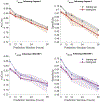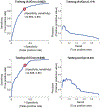Predicting Progression to Septic Shock in the Emergency Department Using an Externally Generalizable Machine-Learning Algorithm
- PMID: 33455840
- PMCID: PMC8554871
- DOI: 10.1016/j.annemergmed.2020.11.007
Predicting Progression to Septic Shock in the Emergency Department Using an Externally Generalizable Machine-Learning Algorithm
Abstract
Study objective: Machine-learning algorithms allow improved prediction of sepsis syndromes in the emergency department (ED), using data from electronic medical records. Transfer learning, a new subfield of machine learning, allows generalizability of an algorithm across clinical sites. We aim to validate the Artificial Intelligence Sepsis Expert for the prediction of delayed septic shock in a cohort of patients treated in the ED and demonstrate the feasibility of transfer learning to improve external validity at a second site.
Methods: This was an observational cohort study using data from greater than 180,000 patients from 2 academic medical centers between 2014 and 2019, using multiple definitions of sepsis. The Artificial Intelligence Sepsis Expert algorithm was trained with 40 input variables at the development site to predict delayed septic shock (occurring greater than 4 hours after ED triage) at various prediction windows. We then validated the algorithm at a second site, using transfer learning to demonstrate generalizability of the algorithm.
Results: We identified 9,354 patients with severe sepsis, of whom 723 developed septic shock at least 4 hours after triage. The Artificial Intelligence Sepsis Expert algorithm demonstrated excellent area under the receiver operating characteristic curve (>0.8) at 8 and 12 hours for the prediction of delayed septic shock. Transfer learning significantly improved the test characteristics of the Artificial Intelligence Sepsis Expert algorithm and yielded comparable performance at the validation site.
Conclusion: The Artificial Intelligence Sepsis Expert algorithm accurately predicted the development of delayed septic shock. The use of transfer learning allowed significantly improved external validity and generalizability at a second site. Future prospective studies are indicated to evaluate the clinical utility of this model.
Copyright © 2020 American College of Emergency Physicians. Published by Elsevier Inc. All rights reserved.
Figures





Update of
-
Predicting progression to septic shock in the emergency department using an externally generalizable machine learning algorithm.medRxiv [Preprint]. 2020 Nov 4:2020.11.02.20224931. doi: 10.1101/2020.11.02.20224931. medRxiv. 2020. Update in: Ann Emerg Med. 2021 Apr;77(4):395-406. doi: 10.1016/j.annemergmed.2020.11.007. PMID: 33173889 Free PMC article. Updated. Preprint.
Similar articles
-
Predicting progression to septic shock in the emergency department using an externally generalizable machine learning algorithm.medRxiv [Preprint]. 2020 Nov 4:2020.11.02.20224931. doi: 10.1101/2020.11.02.20224931. medRxiv. 2020. Update in: Ann Emerg Med. 2021 Apr;77(4):395-406. doi: 10.1016/j.annemergmed.2020.11.007. PMID: 33173889 Free PMC article. Updated. Preprint.
-
Multicentre validation of a sepsis prediction algorithm using only vital sign data in the emergency department, general ward and ICU.BMJ Open. 2018 Jan 26;8(1):e017833. doi: 10.1136/bmjopen-2017-017833. BMJ Open. 2018. PMID: 29374661 Free PMC article.
-
Enhancement in Performance of Septic Shock Prediction Using National Early Warning Score, Initial Triage Information, and Machine Learning Analysis.J Emerg Med. 2021 Jul;61(1):1-11. doi: 10.1016/j.jemermed.2021.01.038. Epub 2021 Apr 1. J Emerg Med. 2021. PMID: 33812727
-
Machine learning for the prediction of sepsis: a systematic review and meta-analysis of diagnostic test accuracy.Intensive Care Med. 2020 Mar;46(3):383-400. doi: 10.1007/s00134-019-05872-y. Epub 2020 Jan 21. Intensive Care Med. 2020. PMID: 31965266 Free PMC article.
-
The role of artificial intelligence in sepsis in the Emergency Department: a narrative review.Ann Transl Med. 2025 Feb 28;13(1):4. doi: 10.21037/atm-24-150. Epub 2025 Feb 25. Ann Transl Med. 2025. PMID: 40115064 Free PMC article. Review.
Cited by
-
Impact of a deep learning sepsis prediction model on quality of care and survival.NPJ Digit Med. 2024 Jan 23;7(1):14. doi: 10.1038/s41746-023-00986-6. NPJ Digit Med. 2024. PMID: 38263386 Free PMC article.
-
Prediction of septic and hypovolemic shock in intensive care unit patients using machine learning.Rev Bras Ter Intensiva. 2022 Oct-Dec;34(4):477-483. doi: 10.5935/0103-507X.20220280-pt. Epub 2023 Mar 3. Rev Bras Ter Intensiva. 2022. PMID: 36888828 Free PMC article.
-
Impact of analytical bias on machine learning models for sepsis prediction using laboratory data.Clin Chem Lab Med. 2025 May 28. doi: 10.1515/cclm-2025-0491. Online ahead of print. Clin Chem Lab Med. 2025. PMID: 40440484
-
Mortality and antibiotic timing in deep learning-derived surviving sepsis campaign risk groups: a multicenter study.Crit Care. 2025 Jul 14;29(1):302. doi: 10.1186/s13054-025-05493-6. Crit Care. 2025. PMID: 40660326 Free PMC article.
-
Leveraging clinical data across healthcare institutions for continual learning of predictive risk models.Sci Rep. 2022 May 19;12(1):8380. doi: 10.1038/s41598-022-12497-7. Sci Rep. 2022. PMID: 35590018 Free PMC article.
References
-
- Villar J, Clement JP, Stotts J, et al. Many emergency department patients with severe sepsis and septic shock do not meet diagnostic criteria within 3 hours of arrival. Ann Emerg Med. 2014;64:48–54. - PubMed
-
- Capp R, Horton CL, Takhar SS, et al. Predictors of patients who present to the emergency department with sepsis and progress to septic shock between 4 and 48 hours of emergency department arrival. Crit Care Med. 2015;43:983–988. - PubMed
-
- Sakr Y, Vincent JL, Schuerholz T, et al. Early- versus late-onset shock in European intensive care units. Shock. 2007;28:636–643. - PubMed
Publication types
MeSH terms
Grants and funding
LinkOut - more resources
Full Text Sources
Other Literature Sources

